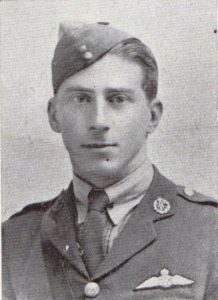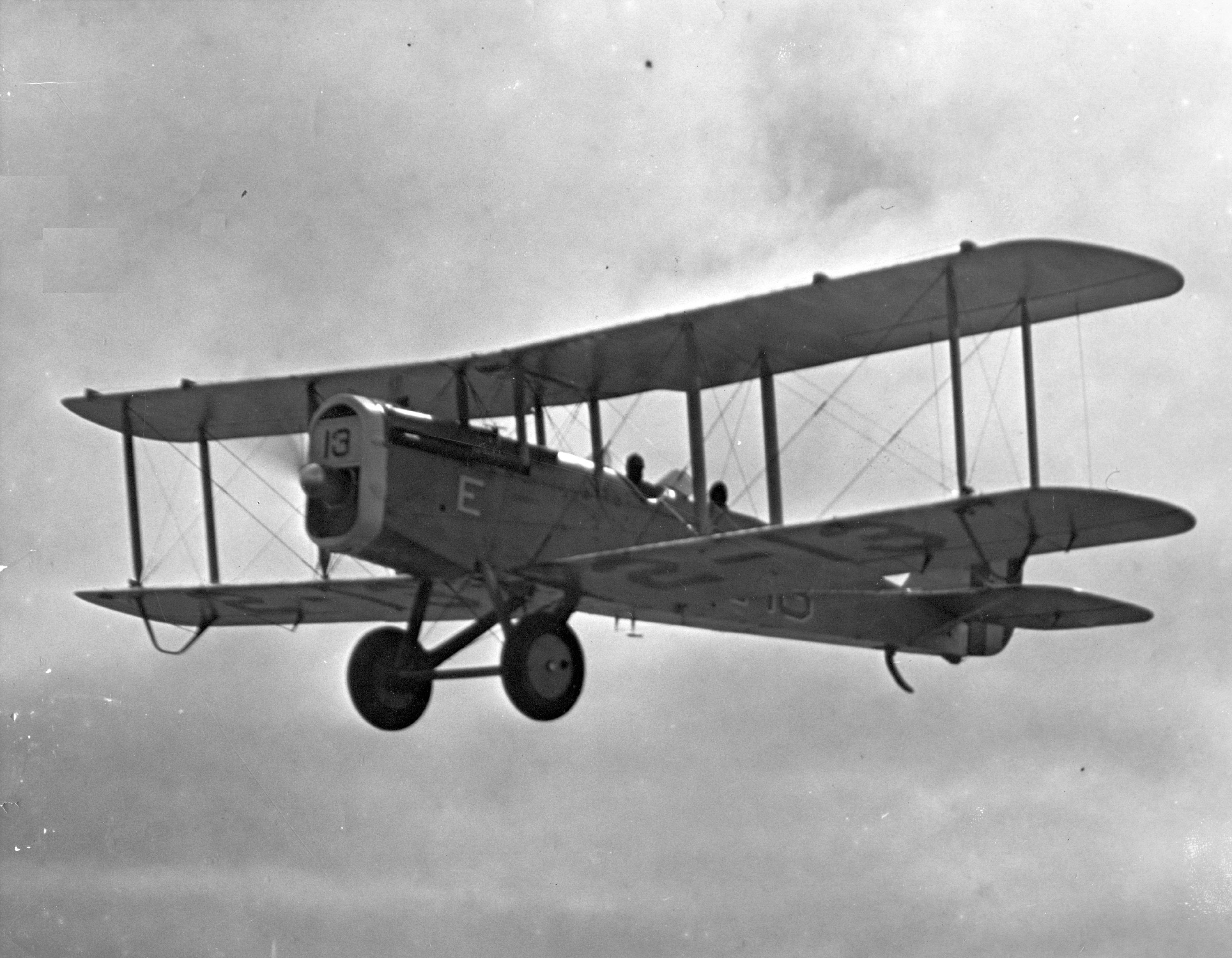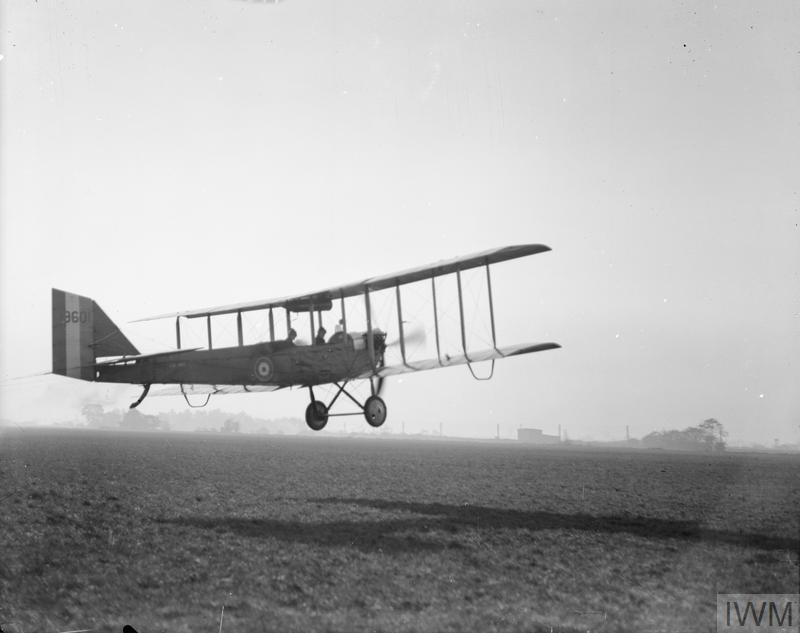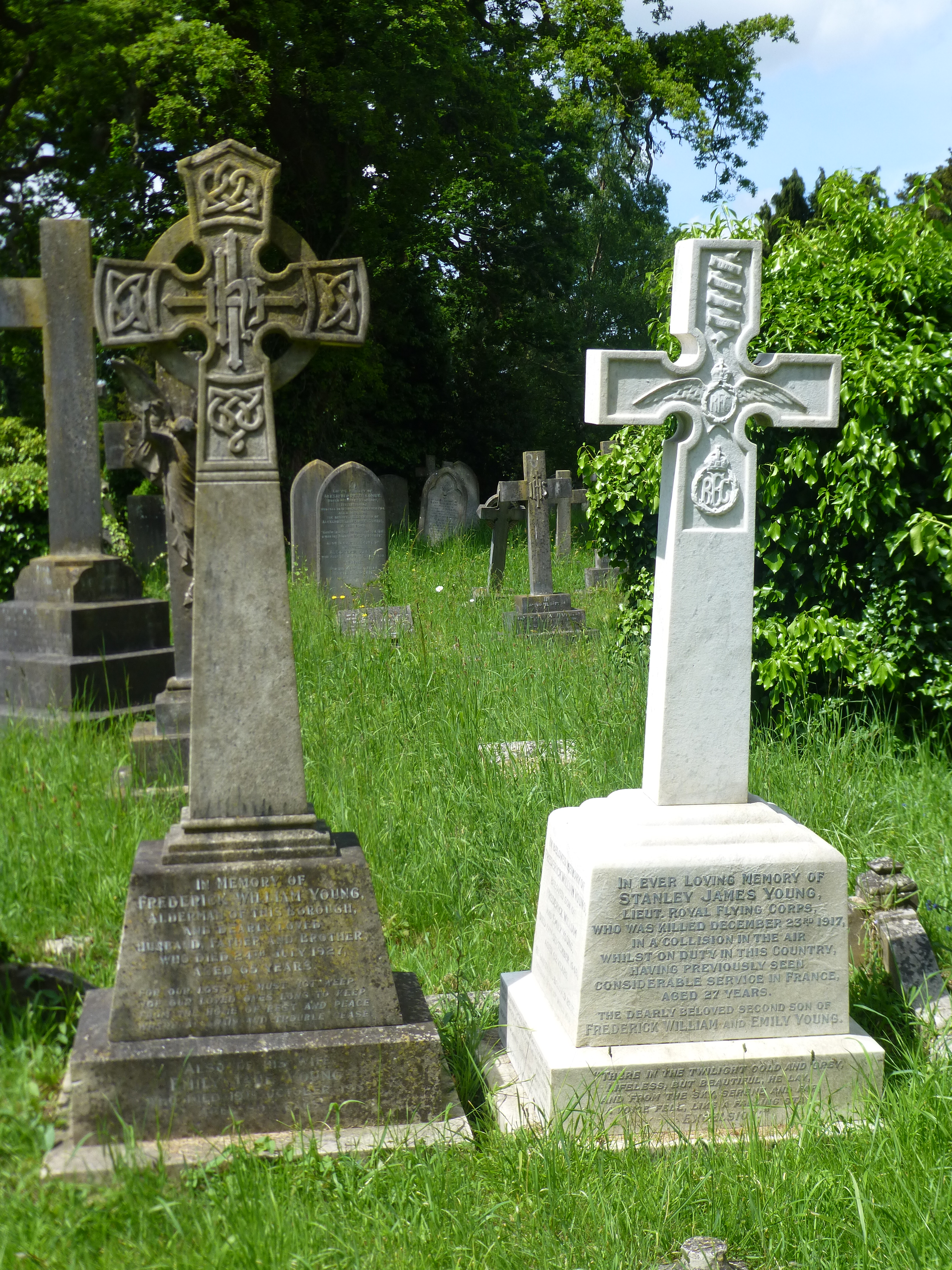 Military unit: Royal Flying Corps
Military unit: Royal Flying Corps
Date & place of birth: 1 March 1890 at Southampton
Date & place of death: 23 December 1917, aged 27 at Stamford, Lincolnshire
Prior to the war, Stanley Young operated a general haulage business. He joined the Royal Flying Corps in July 1916 and was killed in a flying accident the following year.
Family background
Stanley James Young was born at 77 St Andrews Road, Southampton on 1 March 1890, the second son of Frederick William Young (1861–1927) and his wife Emily Jane née Lodder (1860–1951).
Frederick Young was born in Portsmouth, the son of a carpenter & joiner, but moved with his parents to Southampton in about 1869. On 14 May 1883, at Holy Trinity Church, he married Emily Jane Lodder, whose father was a boot & shoe maker.
The couple’s first child, named Frederick William like his father, was born on 23 February 1886, followed by Stanley, four years later on 1 March 1890. Two daughters, Winifred May and Gladys Emily were born on 4 December 1893 and 20 April 1899 respectively.
In the 1889 Kelly’s Directory, Frederick was recorded as resident at 40 St Andrew’s Road, in the St Mary’s district of Southampton, but trading from 5 Clifford Street, in partnership as Building Contractors with his elder brother, John Charles Young. At the time of the 1891 census, the family had moved across the road to No 77, when Frederick gave his occupation as “Builder”.
In the 1899 Kelly’s Directory, Frederick and family living at 6 Upper Chamberlayne Place, Cranbury Avenue in Newtown, Southampton with his brother, John, living next door. Frederick and his family remained at Cranbury Avenue, with the house being named “Runnymede” (and re-numbered as 2 Cranbury Avenue), until sometime during the First World War.
Frederick Young senior became a Southampton town councillor and vice-president of the Trinity Ward Conservative Association.
Education and business career
Stanley was educated at Taunton’s School, Southampton between 1899 and 1906.
On leaving school, he worked as a coal merchant before going into business on his own account as a general haulier in June 1910.
On 13 May 1916, Stanley appeared before the Southampton County Bench charged with “cruelty to a horse by overloading the animal”. On 28 April, an employee of the business had been crossing from Woolston to Itchen on the floating bridge with “a light horse attached to a trolley, on which there were sixteen bags of flour, containing 140 lbs. per bag, and sundry other articles, including a tarpaulin” (“at least 30 cwt., trolley and all”). On leaving the bridge when it reached the Itchen shore, the horse was only able to haul the load five or six yards up the beach before the wheels of the cart sank into the shingle. The horse soon showed signs of distress, when the driver, Arthur Luke, was arrested by an officer from the RSPCA. Arthur Luke then obtained a second horse, and the two animals were able to haul the cart onto the nearby road.
Both the driver and Stanley were found guilty: Arthur Luke was fined 10 shillings and Stanley was fined 40/-.
Alongside his work as a coal merchant, Stanley also worked for the Southampton Poor Law Institution at their offices in St Mary’s Street, adjacent to St Mary’s Church.
He was a keen cricketer, and a member of the Deanery cricket club, and also a member of the Tartan Hockey Club.
Masonic career
Stanley’s father, Frederick, had been initiated into the Lodge of Peace and Harmony No 359 at Southampton, on 20 June 1910.
On 18 September 1916, Stanley was initiated into the Lodge, alongside 27-year old Frederick Brown, a jeweller. On the same evening, two brethren (William Ruffle and James Snowdon) were passed to the second degree. Stanley and Frederick Browne were both passed on 16 October (when Harold Brazier, a 21-year old air mechanic, was initiated).
Both brethren were raised to the degree of Master Mason on 20 November 1916, together with William Ruffle. On the same day, the lodge initiated two brethren (Richard Eagle, a 49-year old manager, and George Wedderburn, a 29-year old soldier, who would be killed on 9 August 1918) and passed Harold Brazier to the second degree.
Military service
In 1908, Stanley enlisted as a gunner in the newly-formed Hampshire Royal Horse Artillery, based at St Mary’s Road drill hall. He remained with the battalion until setting up his own business in June 1910.
On 26 May 1916, he applied to join the Royal Flying Corps. His application was endorsed by Russell Bencraft, the President of Hampshire County Cricket Club. (Bencraft had played cricket for Hampshire between 1876 and 1896, and also served for several years as President of Southampton Football Club.) He was a Past Master of Twelve Brothers Lodge No 785 , into which he had been initiated in February 1897.
His application was successful and, on 22 July 1916, he was appointed as a Second Lieutenant (on probation) in the Special Reserve of Officers of the Royal Flying Corps and directed to attend at Christ’s Church College at Oxford University “for instruction in aviation”.
Stanley was at Oxford for a month until 24 August, when he was posted to 27 Reserve Squadron, moving to 28 Squadron on 4 October, both based at Fort Rowner, near Gosport, Hampshire.

On 8 February 1917, Stanley was promoted to flying officer and posted to France to join 18 Squadron with the British Expeditionary Force, based initially at Bertangles (north of Amiens, about 30 km west of Albert), flying the FE2b, designed by the Royal Aircraft Factory at Farnborough. Initially used for reconnaissance, the Farman Experimental 2 two-seater biplane was a “pusher” with the propeller behind the pilot. Armed with two or three Lewis guns and a camera, the observer sat far forward in the nacelle, directly in front of the pilot, and had to stand in the cockpit to fire his guns. Vulnerable to attacks from the rear, the F.E.2 was frequently shot down. The introduction of more advanced aircraft made the F.E.2 an ineffective fighter and by 1917 it was primarily used for bombing missions.

In May 1917, the squadron were moved to Baizieux (11 km west of Albert), where they were re-equipped with the Airco DH4, a 2-seater bomber. The DH4 was far superior to the FE2b, being much faster and better armed, with the observer behind the pilot having a ring-mounted machine gun. It was “designed to do the jobs the B.E.12 … had failed to do”. (Capt. Cecil Lewis, M.C.)
The squadron moved its base again on 10 July, to La Bellevue aerodrome, about 6 km north-east of Doullens. This was the airfield from which Captain John Revill of Derwent Lodge No 40 in East Sussex was flying when he crashed and was killed on 11 November 1917.
After 6½ months in France, Stanley was recalled to England on 28 August 1917, having been promoted to lieutenant on 1 August. After being deployed for a short time with a testing squadron, in late October he was assigned to the 9th Training Squadron based at Norwich and then to No 1 Training Depot Station at Stamford, Lincolnshire (now RAF Wittering) where he became assistant instructor.

At Stamford, the training depot was equipped with the Airco DH6, a biplane specifically designed as a military trainer.
Death and commemoration
On the morning of 23 December 1917, Stanley took off from Stamford in DH6 B/2631 to check the weather conditions. Immediately on take-off, at a height of less than 200 ft., he collided with DH6 D/2656 piloted by 19-year old 2nd Lieutenant George Longley Lewington (originally from Fair Oak in Hampshire). Both planes fell to the ground, where they burst into flames killing the two pilots.
At the inquest the next day, several witnesses said that the crash was a “pure accident” as the pilots were unable to see each other at the angle at which they were flying. The official accident report found:
The court reviewed the wreckage and considered the evidence, and find that 2/Lt. Lewington and Lt. Young were killed by the result of a collision in the air.
-
-
- The collision was caused by poor visibility at the time of the accident caused by rain and mist.
- Lack of experience of 2/Lt. Lewington who failed to manoeuvre his machine clear when collision was imminent.
- Young making the mistake of turning too soon after taking off but this without (1) and (2) would not account for the accident.
-
Verdicts of “accidental death” were returned.
Stanley was buried on 27 December at the cemetery in Hill Lane, Southampton with full military honours. The funeral service was held at St. Luke’s Church, opposite the family home in Cranbury Avenue. The service was conducted by Revd. Spencer Norfolk, a former Military Chaplain. The pall-bearers were six officers from the Royal Flying Corps.
After the funeral, the coffin was placed on a gun-carriage, drawn by four black horses, and conveyed to the cemetery, preceded by a firing party and buglers drawn from the Worcestershire Regiment, and followed by members of the Royal Flying Corps and a half military company. There was a large number of spectators en route to the cemetery.
 The coffin was buried just inside the cemetery gates on the right of the main path. At the conclusion of the burial service, three volleys were fired in the air by the firing party, who then fixed bayonets and came to attention while the buglers sounded the “Last Post”.
The coffin was buried just inside the cemetery gates on the right of the main path. At the conclusion of the burial service, three volleys were fired in the air by the firing party, who then fixed bayonets and came to attention while the buglers sounded the “Last Post”.
The mourners at the funeral included many family members, including his cousin Hector Young, who was a prominent Freemason and would become Mayor of Southampton in 1929. There were also several other members of Southampton Town Council, including Sidney Kimber, who served as mayor for two years from 1918 to 1920, and his brother, Frank, Past Master of Clausentum Lodge No. 1461. Also present were the Worshipful Master of the Lodge of Peace and Harmony, Wor. Bro. Thomas Lavington, and several members of his lodge and neighbouring lodges, together with representatives of Deanery Cricket Club and the Tartan Hockey Club.
As well as the floral tributes from his family and other mourners, there was one with the poignant note: “To my own Stan, from his devoted girlie, Haze”. (Unfortunately, I have not been able to identify Haze, or Hazel.)
His grave bears the epitaph:
There in the twilight cold and grey,
Lifeless, but beautiful, he lay,
And from the sky, serene and far,
A voice fell, like a falling star.
Excelsior!
(Henry Wadsworth Longfellow)
Stanley is also commemorated on the Cenotaph in Southampton’s Watts (or West) Park.
Stanley’s kit and personal effects were sent to his parents shortly after his death. This included his masonic regalia case.
Subsequent family history
At the end of the war, Stanley’s patents were living at 6 Winn Road, Southampton where they were still living when Frederick died on 24 July 1927. Emily survived her husband by 24 years, dying on 19 October 1951.
Stanley’s brother, Frederick was initiated into The Lodge of Peace and Harmony on 17 May 1920. He gained his pilot’s licence in March 1935.
Sources
airhistory.org.uk – Royal Flying Corps: People Index
Ancestry.co.uk
1891 England Census
1901 England Census
1911 England Census
Army Registers of Soldiers’ Effects, 1901-1929
City and County Directories, 1766 – 1946
National Probate Calendar (Index of Wills and Administrations), 1858-1966
Soldiers Died in the Great War, 1914-1919
United Grand Lodge of England Freemason Membership Records, 1751–1921
WWI Medal Rolls Index Cards, 1914-1920
Bitterne Local History Society: List of Names on the Cenotaph
CWGC: Casualty details: Lieutenant Young, Stanley James
Find a Grave: Lieut Stanley James Young
Great War Forum:
Need help interpreting officer’s career
Hampshire Advertiser:
13 May 1916. Cruelty to a Horse at Itchen
29 December 1917. The Late Lieutenant Stanley Young. Military Funeral at Southampton
29 December 1917. Deaths
London Gazette:
28 July 1916 Supplement: 29688 Page: 7557
8 June 1917 Supplement: 30123 Page: 5708
12 June 1917 Supplement: 30128 Page: 5837
14 September 1917 Supplement: 30283 Page: 9518
Masonic Roll of Honour: Lieutenant Stanley James Young
The National Archives:
WO 339/65570 Lieutenant Stanley James Young
AIR 76/567/37 Young, Stanley James
Nottingham Journal: 26 December 1917. Four Airmen Killed
Old Tauntonians Association: WW1 Casualties – Young, Stanley James
Royal Air Force Museum
Casualty Record: Young, S.J. (Stanley James)
Casualty Forms: Lieut. S J Young
Sotonopedia: Chamberlayne Place
Southampton Cenotaph: Fallen Heroes – Stanley James Young
Sussex History Forum: Young, Stanley James
Photograph credits
Portrait: WW1 Casualties – Young, Stanley James
Royal Aircraft Factory FE2b: Wikimedia Commons
Airco DH4: WW1 Wings of Glory
Airco DH6: Imperial War Museum
Gravestones: Southampton Cenotaph